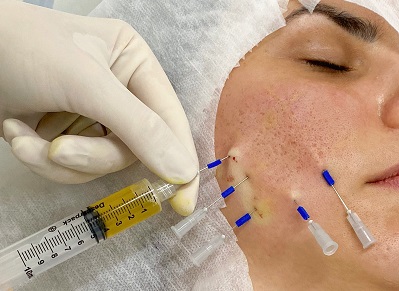Vol. 3 – Number 11 – 2022 Case report Page 8-16 Acne scar treatment with peelings, subcision, polyoxanone threads (PDO) and Platelet Rich Fibrin (PRP) – case report Maria Luiza Gimenez Innecchi Bortoletto¹ Kelly Martins de Oliveira¹ Pedro Carvalho Feitosa² ABSTRACT Acne scarring results from tissue loss and increased tissue proliferation. Atrophic scarring is caused by the loss of collagen that occurs in the inflammatory process of acne. All scars have psychological consequences, as they can affect self-esteem and cause physical pain when moving the affected area. Chemical peels are widely used to treat acne and acne scarring. They cause an injury to the skin or accelerated exfoliation, induced by caustic agents that cause controlled damage, followed by the release of cytokines and mediators of inflammation, resulting in thickening of the epidermis, collagen deposition, reorganization of structural elements and increase in dermal volume. Among the therapeutic modalities of acne scars, subcision is a simple and safe procedure. Subcision frees the scar surfaces and induces the formation of connective tissue directly below the scar. Another method used is the application of plasma rich in platelets and fibrin that release growth factor, essential for wound healing and synthesis of extracellular matrix remodeling. Polydioxanone (PDO) threads induce collagen production, increasing the number of fibroblasts in the tissue where it was inserted. This work presented a case of acne scarring, firstly treated with two applications of 10% ATA peeling and 10% retinoic acid. Then a subcision was made with a duckbill cannula and insertion of PDO wires with PRP in the scar region. Descriptors: Acne, peeling, subcision, PDO, PRP. ¹ CD, Specialist in Orthodontics and Orofacial Harmonization. ² PhD, Specialist and MD in Implant Dentistry, Specialist in Orofacial Harmonization, Specialist in Oral and Maxillofacial Surgery and Traumatology. DOI: 10.24077/2022;3113111
This content is restricted to site members. If you are an existing user, please log in. New users may register below.
LEIA MAIS

